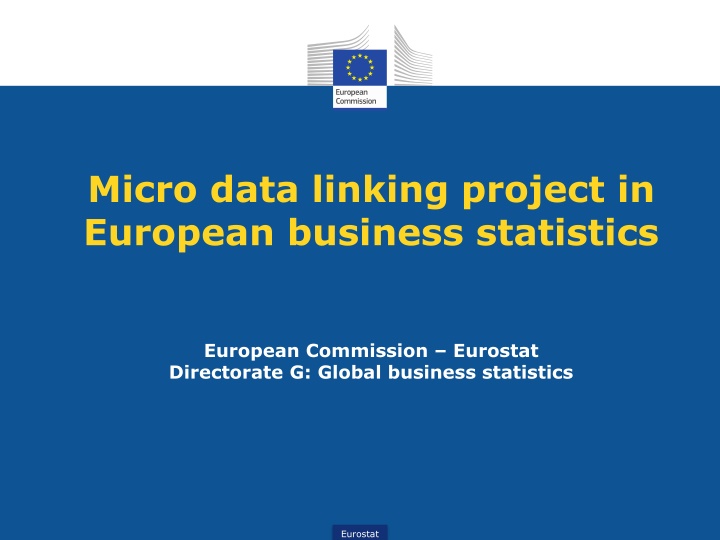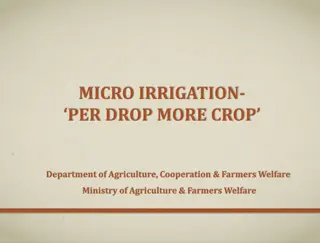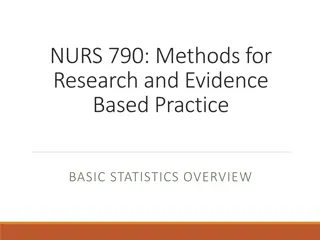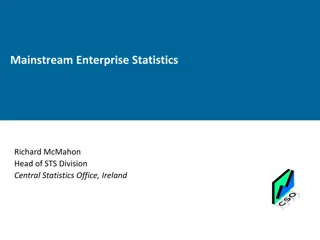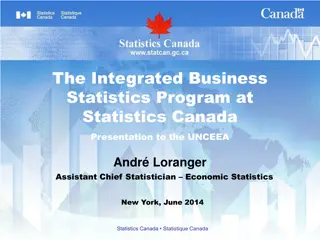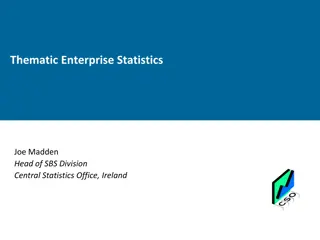European Business Statistics Micro Data Linking Project
Linking micro data in European business statistics is a vital project undertaken by the European Commission's Eurostat Directorate G. The project aims to enhance understanding of enterprises' structure and activities without adding burden on respondent enterprises or national statistical institutes. By combining existing data sets, new information and statistics can be generated to meet policy requirements effectively.
Uploaded on Mar 14, 2025 | 0 Views
Download Presentation

Please find below an Image/Link to download the presentation.
The content on the website is provided AS IS for your information and personal use only. It may not be sold, licensed, or shared on other websites without obtaining consent from the author.If you encounter any issues during the download, it is possible that the publisher has removed the file from their server.
You are allowed to download the files provided on this website for personal or commercial use, subject to the condition that they are used lawfully. All files are the property of their respective owners.
The content on the website is provided AS IS for your information and personal use only. It may not be sold, licensed, or shared on other websites without obtaining consent from the author.
E N D
Presentation Transcript
Micro data linking project in European business statistics European Commission Eurostat Directorate G: Global business statistics Eurostat
Outline of the presentation Why micro-data linking Eurostat MDL projects Pre-conditions and arrangements MDL project results and findings MDL next project Other MDL activities in Europe o FATS mirror Conclusions Eurostat
Why Micro Data Linking (MDL)? Two divergent requests: Users and information on the structure and activities of enterprises. No additional burden on respondent enterprises and budget constraints on national statistical institutes. policy requirements demand additional MDL indicators by combining existing existing data sets but also when combined with possible new data collections. allows delivering new information, statistics and Eurostat
Eurostat MDL projects In 2010 Eurostat launched a MDL project to link data from the International Sourcing (IS) survey with Structural Business (SBS) and International Trade in Goods statistics (ITGS). This was succeeded by a follow-up exercise launched in late 2012 which broadened the scope of the 2010 exercise, including inward foreign affiliate statistics (IFATS). This data linking allowed to profile enterprises engaged in international sourcing in relation development, their value added, their control structure, etc. to their employment Eurostat
MDL project: two pre-conditions There has to be a large enough intersection of responding units. The IS sample was a subset of the SBS population. There has to be a unique identifier or, at least, a very reliable matching approach. The IS and the SBS use national business registers (NBR) as a frame for their population. ITGS is not directly based on NBRs. Therefore, VAT numbers were used to link ITGS data to the NBR and thereby to IS/SBS. Eurostat
MDL project: some arrangements Prior agreement on the variables to be used and on the aggregates to be produced. In requirements and standardised guidelines were provided. order to get a harmonized output, precise data IT support was also provided for the building up of the national linked datasets Statistical confidentiality was respected: micro data files were stored locally at national statistical offices. Eurostat
MDL project: some results Ten countries participated. In most countries employment grew less or fell more between 2008 and 2011 internationally than in enterprises who did not. Foreign-controlled enterprises are much more active in international sourcing and domestically controlled enterprises. In all countries a majority internationally to only one region. In most countries export intensity grew less or fell more between 2008 and 2011 internationally when compared with enterprises who did not. in enterprises sourcing international trade than of enterprises sourced in enterprises sourcing Eurostat
Employment (full-time equivalents), by sourcing status, 2011 (index 2008 = 100) Eurostat
Employment in foreign controlled enterprises by sourcing status, 2011 (index 2008 = 100) Eurostat
Employment in domestically controlled enterprises by sourcing status, 2011 (index 2008 = 100) Eurostat
International sourcing by control Eurostat
Number of regions to which manufacturing enterprises are sourcing internationally Eurostat
Export of goods intensity, by international sourcing status, 2011 (index 2008 = 100) Eurostat
MDL next project New project on-going with 9 countries. More statistical domains involved: Again IS, SBS and ITGS International Trade in Services Statistics Community Innovation Survey ICT usage and e-Commerce in enterprises Survey FATS (Inward and Outward) Business Demography National Business Registers. Results available in 2016. Final aim is to create data sets that could become part of regular production of business statistics Eurostat
Other MDL activities in Europe Micro data on ICT Usage, where business registers were linked with SBS and ICT usage and e-commerce data. TEC development). (regular data collection) and STEC (under Data warehousing and MDL (methodological) Data linking of statistics on the activities of affiliates based abroad (OFATS) with statistics on foreign affiliates resident in the local economy (IFATS): NO. mirror data for DK, FI and Eurostat
FATS mirror: basic figures Eurostat
FATS mirror: looking at employment Eurostat
MDL: some conclusions MDL has significant potential to provide new statistical evidence without increasing the burden on respondents. MDL gives new insights into the behaviour and activities of enterprises MDL is an additional way of ensuring data quality and consistency between related datasets. Cooperation between national statistical offices to undertake an MDL coordinated approach is a cost-effective way and ensures harmonised, comparable results across countries. MDL has further potentials, e.g. design of new surveys: the survey questionnaire can be limited to questions for which data is not available from existing sources. Eurostat
Thank you for your attention! Eurostat
